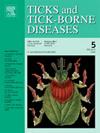与蜱虫一起生活:关于欧洲学术环境中蜱虫和蜱传病原体的知识,态度和实践(KAP)在线调查的结果
IF 3.4
2区 医学
Q2 INFECTIOUS DISEASES
引用次数: 0
摘要
我们准备了一份数字问卷,以获取20种语言关于蜱虫和蜱传病原体的知识、态度和实践(KAP)。调查问卷分布在欧洲22个国家的21所大学和研究机构,收集了9401份有效回复。大多数调查参与者正确地识别了蜱虫,并认为蜱虫是严重的健康风险。对该国或地区的蜱虫活动、栖息地和主要TBPs也有很好的了解。此外,大多数受访者都熟悉有效的蜱虫保护和清除措施。超过75%的受访者被蜱虫咬过,多达12%的参与者在过去被诊断患有蜱传感染。来自北欧和中欧国家的受访者报告说,与来自南欧的受访者相比,他们更频繁地从事户外活动,报告说蜱虫叮咬和tbp感染的频率增加。北欧和中欧国家的受访者也比地中海国家的受访者更了解关于蜱虫和tbp的国家信息运动。这项研究确定了来自一些欧洲国家的受访者之间的知识差距,这些国家历史上没有优先考虑TBPs。这些知识差距应该由信誉良好的机构来解决,以鼓励个人保护行为,而不会引起恐慌,并防止一些社交媒体来源传播的不正确和不可靠信息的传播。本文章由计算机程序翻译,如有差异,请以英文原文为准。
Living with ticks: Results of an online survey of the knowledge, attitudes and practices (KAP) regarding ticks and tick-borne pathogens in academic environments across Europe
We prepared a digital questionnaire to capture knowledge, attitudes and practices (KAP) regarding ticks and tick-borne pathogens (TBPs) in 20 languages. The questionnaire was distributed to 21 universities and research institutions in 22 European countries and 9401 valid responses were collected. Most survey participants identified ticks correctly and regarded ticks as a serious health risk. There was also a good level of knowledge regarding tick activity, habitats and the predominant TBPs in the country or region. Moreover, most respondents were familiar with effective tick protection and removal measures. Over 75 % of respondents had been bitten by ticks and up to 12 % of participants had been diagnosed with a tick-borne infection in the past. Respondents from northern and central European countries who reported engaging in outdoor activities more frequently, reported increased frequencies of tick bites and infection with TBPs compared to respondents from southern Europe. Awareness of national information campaigns on ticks and TBPs was also greater among respondents from northern and central European countries than among Mediterranean countries.
This study identified knowledge gaps among respondents from some European countries where TBPs have not been prioritised historically. These knowledge gaps should be addressed by reputable bodies to encourage personal protective behaviours without causing alarm and to forestall the spreading of incorrect and unreliable information propagated by some social media sources.
求助全文
通过发布文献求助,成功后即可免费获取论文全文。
去求助
来源期刊

Ticks and Tick-borne Diseases
INFECTIOUS DISEASES-MICROBIOLOGY
CiteScore
6.90
自引率
12.50%
发文量
185
审稿时长
6-12 weeks
期刊介绍:
Ticks and Tick-borne Diseases is an international, peer-reviewed scientific journal. It publishes original research papers, short communications, state-of-the-art mini-reviews, letters to the editor, clinical-case studies, announcements of pertinent international meetings, and editorials.
The journal covers a broad spectrum and brings together various disciplines, for example, zoology, microbiology, molecular biology, genetics, mathematical modelling, veterinary and human medicine. Multidisciplinary approaches and the use of conventional and novel methods/methodologies (in the field and in the laboratory) are crucial for deeper understanding of the natural processes and human behaviour/activities that result in human or animal diseases and in economic effects of ticks and tick-borne pathogens. Such understanding is essential for management of tick populations and tick-borne diseases in an effective and environmentally acceptable manner.
 求助内容:
求助内容: 应助结果提醒方式:
应助结果提醒方式:


